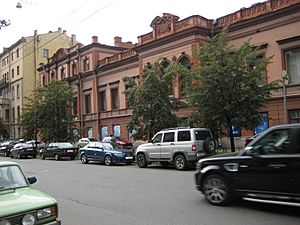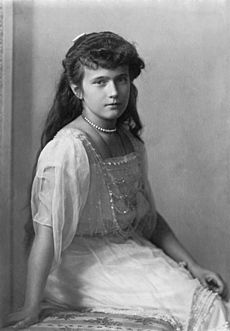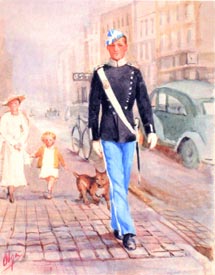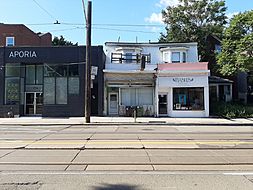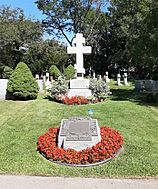Grand Duchess Olga Alexandrovna of Russia facts for kids
Quick facts for kids Grand Duchess Olga Alexandrovna of Russia |
|
|---|---|
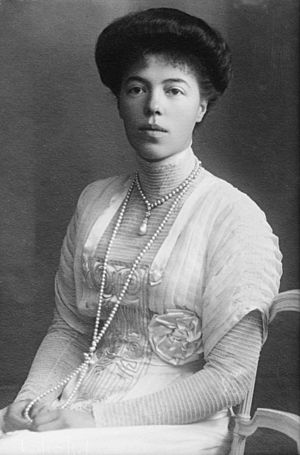
Olga Alexandrovna c. 1910
|
|
| Born | 13 June 1882 [O.S. June 1] Peterhof Palace, Saint Petersburg, Russian Empire |
| Died | 24 November 1960 (aged 78) Toronto, Ontario, Canada |
| Burial | York Cemetery, Toronto |
| Spouse |
Duke Peter Alexandrovich of Oldenburg
(m. 1901; annulled 1916)Nikolai Kulikovsky
(m. 1916; died 1958) |
| Issue | Tikhon Nikolaevich (1917–1993) Guri Nikolaevich (1919–1984) |
| House | Holstein-Gottorp-Romanov |
| Father | Alexander III of Russia |
| Mother | Dagmar of Denmark |
Grand Duchess Olga Alexandrovna of Russia (Russian: О́льга Алекса́ндровна; 13 June 1882 – 24 November 1960) was the youngest child of Emperor Alexander III of Russia and the younger sister of Emperor Nicholas II.
Olga grew up at the Gatchina Palace near Saint Petersburg. She had a close relationship with her father, but her mother, Empress Marie, was more distant. When Olga was 12, her father died, and her brother Nicholas became emperor. In 1901, at age 19, she married Duke Peter Alexandrovich of Oldenburg. Their marriage was not a happy one, and it was later ended in 1916. The next month, Olga married a cavalry officer named Nikolai Kulikovsky. During World War I, Olga worked as an army nurse and was given a medal for her bravery.
When the Romanov family lost power in the Russian Revolution of 1917, Olga, her husband, and their children escaped to Crimea. They lived there under threat, as her brother Nicholas and his family were killed by revolutionaries. Olga and her family managed to escape Russia in February 1920. They joined her mother, the Dowager Empress, in Denmark.
In Denmark, Olga helped her mother and often met people who claimed to be her dead relatives. She met Anna Anderson, the most famous of these people, in 1925. After her mother died in 1928, Olga and her husband bought a dairy farm near Copenhagen. She lived a simple life, raising her two sons, working on the farm, and painting. She painted over 2,000 artworks, which helped her family and supported charities.
In 1948, because of threats from Joseph Stalin's government, Olga and her family moved to a farm in Campbellville, Ontario, Canada. As she got older, Olga and her husband moved to a smaller home near Cooksville, Ontario. Colonel Kulikovsky died in 1958. Two years later, Olga's health got worse, and she moved to an apartment in East Toronto. She died at age 78, seven months after her older sister, Xenia. Olga is often remembered as the last Grand Duchess of Imperial Russia.
Contents
Early Life and Family
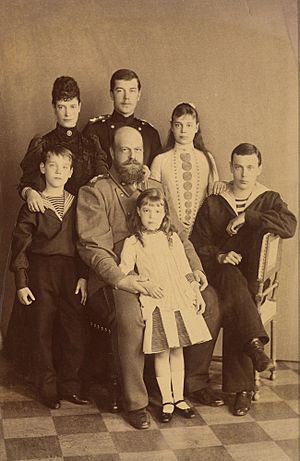
Olga was the youngest daughter of Emperor Alexander III and Empress Marie. She was born on June 13, 1882, at the Peterhof Palace near Saint Petersburg. Her birth was announced with a traditional 101-gun salute. Her mother placed Olga in the care of an English nanny, Elizabeth Franklin.
The Russian imperial family was often a target for assassins. For safety, Olga and her siblings grew up at the Gatchina Palace, about 50 miles (80 km) west of Saint Petersburg. Even though they lived in a palace, their rooms were simple. They slept on hard beds, woke up early, washed with cold water, and ate plain porridge for breakfast.
In 1888, Olga left Gatchina for the first time to visit the Caucasus. On their way back, their train had a terrible accident. The dining car was badly damaged, and the roof collapsed. Olga's parents and four older siblings were eating lunch there. Her father, the Tsar, was said to have held up the roof so others could escape. Twenty-one people died in the crash. Empress Marie helped care for the injured.
Olga and her siblings were taught at home by private tutors. They learned history, geography, Russian, English, and French. They also had drawing and dancing lessons. They learned to ride horses at a young age and became skilled riders. The family was very religious. They celebrated Christmas and Easter, but during Lent, they avoided meat, dairy, and entertainment.
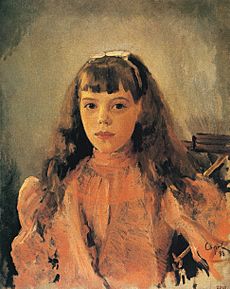
Empress Marie was formal with Olga, and their relationship was difficult. However, Olga, her father, and her youngest brother, Michael, were very close. They often went on hikes in the Gatchina forests, where the Tsar taught Olga and Michael about nature.
Family holidays were spent in the summer at Peterhof and with Olga's grandparents in Denmark. In 1894, Olga's father became very ill. The annual trip to Denmark was canceled. On November 13, 1894, he died at age 49. This was a very sad time for Olga, who was only 12. Her oldest brother, Nicholas II, became the new Tsar.
Life at Court and First Marriage
Olga was supposed to join high society events in 1899 when she was 17. But after her brother George died, her first public appearance was delayed until 1900. She did not enjoy it, saying she felt like "an animal in a cage." From 1901, Olga was the honorary Commander-in-Chief of the 12th Akhtyrsky Hussar Regiment. This army group was famous for winning against Napoleon in 1813.
Around 1900, Olga, then 18, was often seen at the theater and opera with Duke Peter Alexandrovich of Oldenburg. He was a distant cousin and 14 years older than her. Peter asked Olga to marry him the next year. Olga was very surprised by his proposal. She later said, "I was so taken aback that all I could say was 'thank you'."
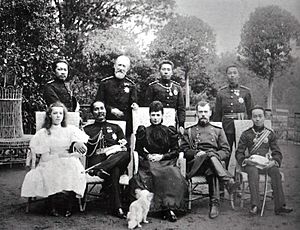
Their engagement was announced in May 1901. Many people were surprised because they thought Peter was not interested in marriage. On August 9, 1901, 19-year-old Olga married 33-year-old Peter. Olga thought Peter's mother had pushed him to propose. Some historians believe Olga accepted to gain independence from her own mother or to avoid marrying into a foreign royal family.
The couple first lived with Peter's parents. Olga did not get along with her mother-in-law, Eugénie. A few weeks after their wedding, Olga and Peter traveled to France and Italy. When they returned to Russia, they moved into a large 200-room palace in Saint Petersburg. This palace was a gift from Tsar Nicholas II to his sister. Olga had her own art studio there. She was unhappy in her marriage and sometimes felt very sad.
Near the Oldenburgs' estate, Ramon, Olga had her own villa called "Olgino." She used her own money to support the local school and built a hospital. She learned basic medical care from the local doctor. She also painted religious icons and gave them to charities. At Ramon, Olga and Peter enjoyed walking in the woods and hunting. Peter was kind to her, but Olga wished for a loving marriage and children.
In April 1903, Olga met Nikolai Kulikovsky, a military officer. The same year, at age 22, she asked her husband for a divorce. He refused but said he might think about it again after seven years.
From 1904 to 1906, Duke Peter worked in Tsarskoye Selo, a palace complex near Saint Petersburg. Olga became very close to her brother Nicholas and his family, who lived nearby. Olga loved her four nieces, the Tsar's daughters. From 1906 to 1914, Olga took her nieces to parties in Saint Petersburg every weekend during the winter. She was especially fond of the youngest, Anastasia, her god-daughter. Olga also met Grigori Rasputin, a holy man who claimed to have healing powers. Olga did not believe in his powers and disliked him.
Public anger grew in Russia because of the Russo-Japanese War (1904–1905) and demands for political changes. In 1905, revolutionaries fired at the Winter Palace. Olga and her mother were unharmed but covered in glass splinters. Later, on "Bloody Sunday," Cossack troops killed many people during a protest. A month later, Olga's uncle was killed. Uprisings happened across the country. Olga supported the new prime minister, Pyotr Stolypin, who tried to make reforms, but he was killed in 1911. All these events, along with her unhappy marriage, caused Olga a lot of stress.
War and Revolution

On August 1, 1914, World War I began. Olga's regiment, the Akhtyrsky Hussars, appeared before her and the Tsar. Nikolai Kulikovsky joined the Hussars, who were sent to the front lines. Olga, using her medical knowledge, began working as a nurse at a Red Cross hospital near the front. She even came under heavy fire while helping soldiers. Nurses rarely worked so close to the fighting. For her bravery, she received the Order of St. George. As Russia lost ground, Olga's hospital moved to Kiev.
In 1916, Tsar Nicholas II ended Olga's marriage to Duke Peter. This allowed her to marry Colonel Kulikovsky. The wedding took place on November 16, 1916, in Kiev. Only a few close family members and friends were there.
During the war, tensions and economic problems grew in Russia, leading to revolutionary feelings. After Tsar Nicholas II gave up his throne in early 1917, many Romanov family members were held under house arrest. To find safety, Olga, her mother, and other family members traveled to Crimea. They lived at Alexander's estate, Ay-Todor, under house arrest. On August 12, 1917, Olga's first son, Tikhon Nikolaevich, was born there.
The Romanovs in Crimea did not know what happened to the Tsar and his family. Nicholas, Alexandra, and their children were later killed by revolutionaries. In March 1918, German forces advanced on Crimea, and German guards replaced the revolutionary ones. In November 1918, the Germans left, and Allied forces arrived. This allowed the surviving Romanovs to escape. Olga's mother and most of her family were evacuated by a British warship.
Olga and her husband decided to stay in Russia. They moved to a Cossack village called Novominskaya. There, Olga gave birth to her second son, Guri Nikolaevich, on April 23, 1919. In November 1919, they had to flee again from revolutionary troops. They escaped to Novorossiysk and then to a refugee camp in Turkey. After two weeks, they went to Belgrade. Olga was then called to Denmark by her mother. On Good Friday 1920, Olga and her family arrived in Copenhagen. They lived with the Dowager Empress, where Olga helped her mother as a secretary and companion.
Life in Exile and Anna Anderson
In 1925, Olga and Colonel Kulikovsky went to Berlin to meet Anna Anderson. Anderson claimed to be Olga's niece, Grand Duchess Anastasia Nikolaevna of Russia. Anderson told a story about escaping Russia. Olga thought the story was "clearly false."
Olga met Anderson, who was sick with tuberculosis, at a nursing home. Olga was also upset that Anderson only spoke German. Anastasia, Olga's niece, spoke English and Russian fluently but did not know German. Olga felt sorry for Anderson, thinking she was ill.
Olga initially wasn't sure if Anderson was Anastasia. However, within a month, she decided. She wrote to a friend, "There is no resemblance, and she is undoubtedly not A." Olga sent Anderson a scarf and five letters. Anderson's supporters used these to claim Olga recognized her. Olga later said she sent them "out of pity" and called the claims "a complete fabrication." When Olga publicly denied that Anderson was Anastasia, Anderson's supporters claimed Olga was told to do so by her sister. Olga denied this, and no such message was ever found.
Danish Residency and Move to Canada
The Dowager Empress died on October 13, 1928. Her estate was sold, and Olga used her share to buy a farm called Knudsminde in Ballerup, near Copenhagen. She and her husband raised horses, cows, pigs, and chickens. Olga lived a simple life, working on the farm, doing chores, and painting.
The farm became a meeting place for Russian royal supporters in Denmark. Many Russian emigrants visited. Olga kept in touch with the Russian emigrant community. She also began selling her paintings of Russian and Danish scenes. She held exhibitions in Copenhagen, London, Paris, and Berlin. Some of the money she earned was given to charities.
In 1940, Nazi Germany invaded Denmark. Food shortages and travel restrictions followed. Olga's sons, Tikhon and Guri, were officers in the Danish Army. They were held as prisoners of war for a short time. Olga continued to help Russian emigrants who were fighting against communism. In May 1945, German forces in Denmark surrendered.
After World War II, Soviet troops occupied a Danish island. The Soviet Union accused Olga of working against them. The Romanovs in Denmark feared being kidnapped or killed. Olga decided to move her family to the safety of Canada.
Moving to Canada
In May 1948, the Kulikovskys traveled to London. They stayed at Hampton Court Palace while they prepared to move to Canada as farmers. On June 2, 1948, Olga, Kulikovsky, their sons Tikhon and Guri, their wives, and two grandchildren left Liverpool. They arrived in Halifax, Nova Scotia. The family lived in Toronto before buying a 200-acre (0.81 km2) farm near Campbellville, Ontario.
By 1952, the farm was too much work for Olga and her husband. They were both old, their sons had moved away, and the Colonel was often ill. They sold the farm and moved to a smaller house in Cooksville, Ontario, a suburb of Toronto. Olga's loyal maid, Mimka, had a stroke, and Olga cared for her until Mimka died in 1954.
Many people, including important visitors and royals, came to see Olga at her home. Among them were her relatives, like Princess Marina, Duchess of Kent, and Louis Mountbatten. In June 1959, Queen Elizabeth II and Prince Philip visited Toronto and invited Olga for lunch on the royal yacht. Olga's home also attracted people who claimed to be Romanov family members, which Olga and her family found annoying.
By 1958, Olga's husband was almost paralyzed. She sold some of her jewelry to get money. After her husband died in 1958, Olga became very weak. She was hospitalized in April 1960. She was not told that her older sister, Xenia, died that same month. Unable to care for herself, Olga moved in with friends in an apartment in East Toronto. She fell into a coma on November 21, 1960, and died on November 24 at age 78.
She was buried next to her husband in York Cemetery, Toronto, on November 30, 1960. The funeral service was held at Christ the Saviour Cathedral. Officers from the Akhtyrsky Hussars stood guard. Even though she lived simply and bought cheap clothes, her estate was worth more than 200,000 Canadian dollars.
Her Paintings
Olga started drawing and painting when she was young. She painted throughout her life, creating over 2,000 artworks. She painted on paper, canvas, and ceramic. Her favorite subjects were nature scenes and landscapes, but she also painted portraits and still lifes.
Her paintings were a good way for her to earn money. Olga preferred to show her art in Denmark to avoid the business side of the North American art market. A program called the Russian Relief Programme, started by her son Tikhon, has shown her work in many cities. These include Washington, Moscow, and Saint Petersburg. Queen Elizabeth II of Britain and King Harald V of Norway own some of her paintings. The Ballerup Museum in Denmark has about 100 of her artworks.
See also
 In Spanish: Olga Aleksándrovna Románova para niños
In Spanish: Olga Aleksándrovna Románova para niños


